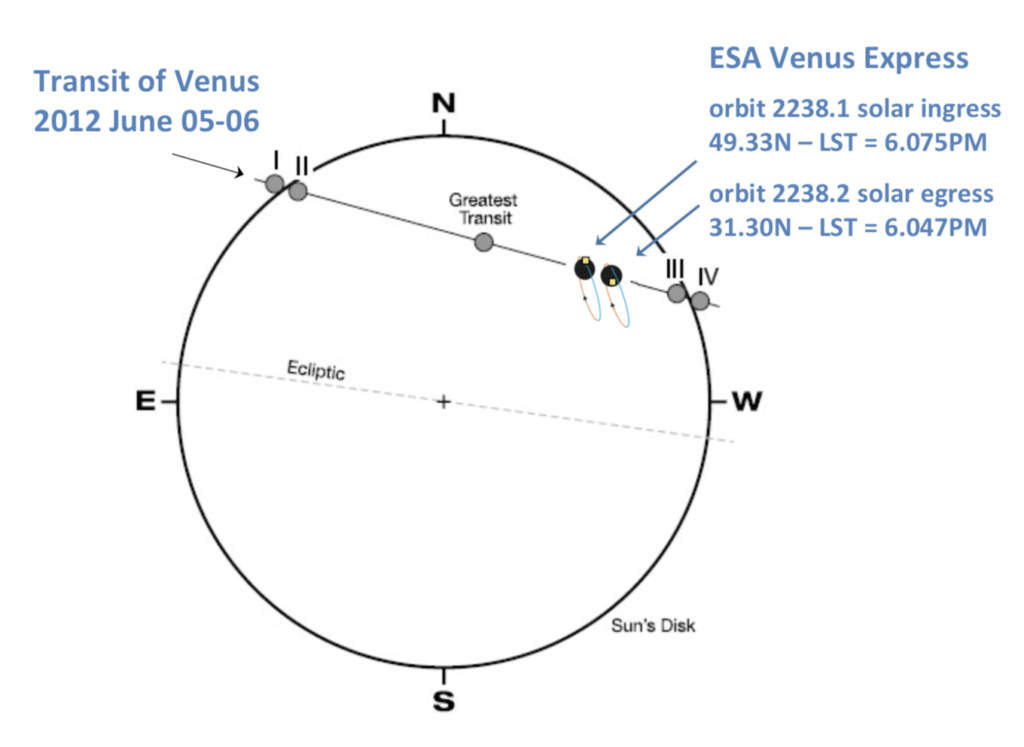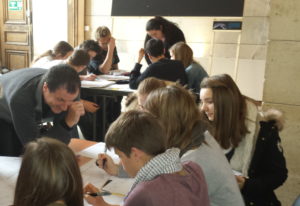Astronomy and architecture (with Yann Rocher, Radio France Internationale, Autour de la Question, Dec 2017)

A l’occasion de la parution du catalogue de l’exposition Globes. Architecture & sciences explorent le monde, qui s’est tenue du 10 nov. 2017 au 28 mars 2018 à la Cité de l’architecture et du patrimoine à Paris, paru aux éditions Norma, Thomas Widemann et l’architecte Yann Rocher s’interrogent sur la figure de la sphère en astronomie et en architecture (Podcast RFI Autour de la Question, 14 décembre 2017)
European Commission Research Project EuroVenus (2013-2016)

In 2013, the European Commission selected a 2.2M€ proposal submitted in the framework of the European Commission’s FP7 SPACE Program, EuroVenus, to support ESA’s Venus Express exploitation of data in 5 European countries (France, Portugal, UK, Belgium, and Germany, lead proposer T. Widemann, Observatoire de Paris). The program purpose was (1) to enhance the legacy of European Space Agency’s Venus Express data through cross-validation with complementary ground-based telescopic observations; (2) position key European research groups to continue to lead Venus research after the end of the Venus Express mission; (3) to strengthen the position of European researchers in the emerging field of comparative planetology, and in future ESA and NASA mission proposals.

See our EU program youtube channel and the 52-min documentary produced by award winning production company WhiteFox Pictures.
National & European Media

- Vénus : la fausse jumelle de la Terre ? (with A. Le Gall, France Culture, La Méthode Scientifique, Jan 2019)
Quel portrait peut-on dresser de Vénus ? Pourquoi manque-t-on autant de données sur cette planète jumelle de la Terre ? Quelles sont les missions d’exploration en cours et à venir ? – A 58-min podcast of France Culture’s La Méthode Scientifique with EnVision SST members T. Widemann and A. Le Gall.
- Observatoire de Paris : 350 ans, la tête dans les étoiles (with F. Combes, France Culture, La Méthode Scientifique, Février 2017)
Dans quel contexte et pour quels objectifs a-t-il été érigé ? Quels sont les grands savants qui ont permis son rayonnement pour la culture et la puissance de la France ? Quelles ont été les astronomiques, et dans les autres sciences au cours de ces derniers siècles ? – A 58-min podcast of France Culture’s La Méthode Scientifique with T. Widemann and F. Combes.
In June 2012, planetary scientists had their last opportunity to observe a transit of Venus before the 22nd century (Dec. 2117 – Dec. 2125). These rare events have been historically important for astronomers in trying to determine the distance of the Sun from the Earth. In theory, this distance can be calculated by observing a transit from different locations. This method was first suggested in 1677 by United Kingdom’s Astronomer Royal, Edmond Halley. For the coming opportunities of observing a transit of Venus (in 1761 and 1769), challenging and sometimes tragic overseas expeditions were organised. In 1761, a thin arc of light – encircling the planet at the beginning and end of the transit, on the portion projected outside the Solar limb – was detected for the first time, and further described in 1769 as caused by an atmosphere around Venus.
In 2004, the first transit since 1882, this aureole created by the halo of atmosphere around Venus immediately before and immediately after the transit was rediscovered. The brightness of the aureole, and its evolution over time outside of the solar disk could be reproduced by modeling the refraction (bending) of light in the planet’s atmosphere. On June 5-6, 2012, Paolo Tanga (Observatoire de la côte d’Azur, Nice) and myself used a variety of acquisition systems to record the aureole photometry – ranging from amateur-sized to telescopes and cameras to NASA and JAXA Earth-orbiting solar telescopes – thus collecting for the first time a large amount of quantitative information on this atmospheric phenomenon. In Tanga et al. (2012) we have shown that the aureole photometry reflects the local density scale height and the altitude of the refracting layer.


The solar disk with the trajectory of Venus during the transit of June 5-6, 2012, as seen from the Earth geocenter. The positions of the contacts (I to IV) are indicated, as well as the orbit of European Space Agency’s Venus Express orbiter around the planet, projected to scale. Venus is shown at its location during orbit 2238 when SOIR data were collected at the time of apparent solar ingress at 49.33N on evening terminator at 6.075PM Local Solar Time (LST). At the scale used in Fig. 1, the parallax effect from a site on the Earth surface, or from the position of SDO, is negligible. For data reduction, accurate positions of Venus relative to the Solar limb are derived directly from HDO/HMI images.
The instruments used for the 2012 campaign were specifically adapted portable telescopes equipped with a Lyot coronograph, a device that hides the solar disk to enhance the contrast of the faint aureole, and using different filters to studying the Venus transit at several different wavelengths. By deploying this unique instrument, we were proud to honor a three-century long tradition at Paris Observatory with Joseph-Nicolas Delisle (1688-1768) for the transits of 1761 and 1769, and Jules Janssen (1824-1907) for the transits of 1874 and 1882. Today, thanks largely to NASA’s dedicated Kepler spacecraft, more than 1000 transiting exoplanets have been identified, and astronomers are on the verge of finding exoplanets the size of Earth and Venus orbiting their stars at comparable distances.
Astronomy and Art (with Y. Naze, France Inter, La tête au carré, Dec. 2015)
L’art peut mettre certaines idées scientifiques en perspective et les inspirer à son tour, dans un but de représentation. Invitation au voyage aux frontières mouvantes et incertaines des plus belles réalisations de l’esprit humain. – A 58-min podcast of France Inter’s La tête au carré with T. Widemann and Y. Nazé.
Astronomy in Antiquity
Mars 2014 – Une Journée Découvrir l’Antiquité sur le thème des sciences dans l’Antiquité est organisée à l’Observatoire de Paris, salle Cassini, Mar. 25, 2014 – L’association « Journées Découvrir l’Antiquité » (JDA) est une association fondée par des étudiants et jeunes chercheurs en Sciences de l’Antiquité de l’Ecole Normale Supérieure de Paris. Elle organise chaque année des journées visant à faire découvrir les mondes antiques à des classes d’élèves du secondaire venues de toute la France. Des exemples de thèmes sont par exemple « L’art, les dieux, les hommes en Grèce antique », « la philosophie antique : un art de vivre »..
- 2014 – Une première astronautique : l’aérofreinage de la mission Vénus Express – Le Monde
- 2013 – Le projet EuroVenus, Radio-France-Internationale, Chronique de l’Espace, Dec. 7, 2013
- 2012 – Conference at world’s University Centre in Svalbard (UNIS), Norway : History of Venus transits.
- 2012 – Science News@Analysis, Vol. 336, 11 May 2012 : Venus’s Rare Sun Crossing May Aid Search for Exoplanets
Books







